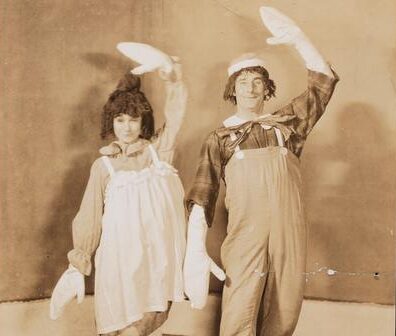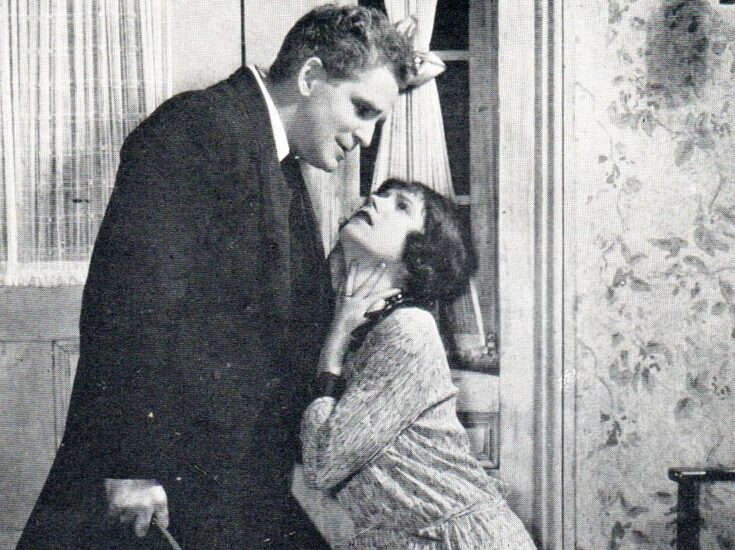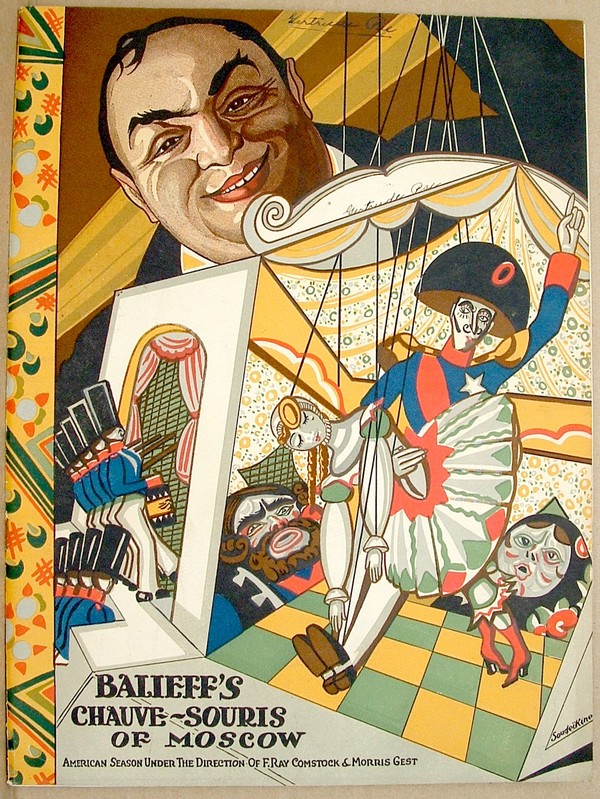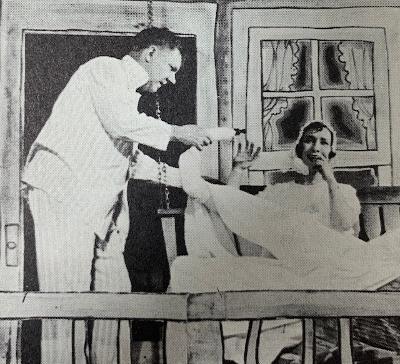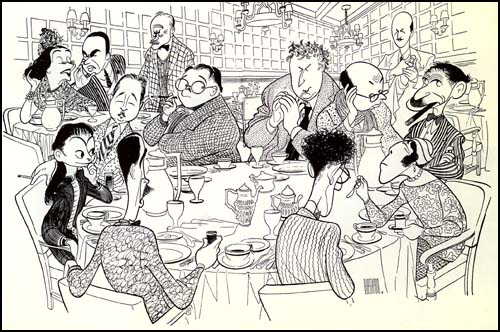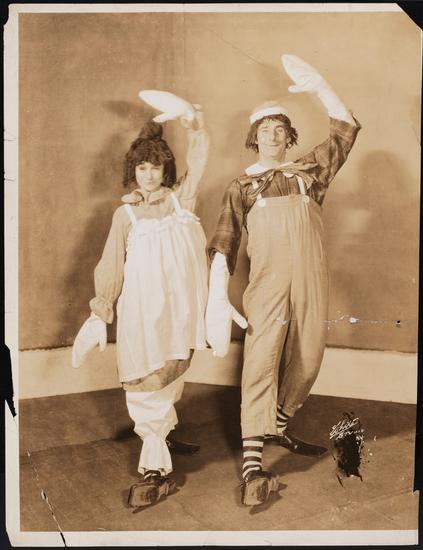
By Samuel L. Leiter
It’s been a rough few weeks, but, after shedding some heavy burdens (not all of them, of course), Leiter is back with “Leiter Looks Back,” this installment reminding us of five long-forgotten musicals from the busy but less than exciting Broadway musical season of 1923-1924. I’m talking about book musicals, which competed energetically with revues, although there remained a fluidity between the genres that sometimes makes it hard to label a particular show. Thus, when I note that there were twenty-one book musicals in 1923-1924, some might question whether one or two might not as easily have been classed as a revue.
In case you’re interested, here are the titles, listed chronologically, of shows enough like book musicals to make the cut: Helen of Troy, New York, Little Jessie James, Little Miss Bluebeard, The Magic Ring, Ginger, Runnin’ Wild, Steppin’ Stones, Sharlee, One Kiss, Mary Jane McKane, The Rise of Rosie O’Reilly, Kid Boots, Lollipop, Kid Boots, Lollipop, Moonlight, The Chiffon Girl, Paradise Alley, Sitting Pretty, Peg o’ My Dreams,’ Plain Jane, I’ll Say She Is!, and Flossie.
So while selecting five is a matter of picking the chaff from the chaff, several were certainly entertaining enough to make some kind of mark. These would be New Helen of Troy, New York; Little Jessie James; Runnin’ Wild; Stepping Stones and Kid Boots. I was tempted to include I’ll Say She Is! in which the Marx Brothers made their hilarious Broadway debut. However, even with its thin storyline it’s usually called a revue, so I’ll get around to it when looking at the season’s offerings in that genre.
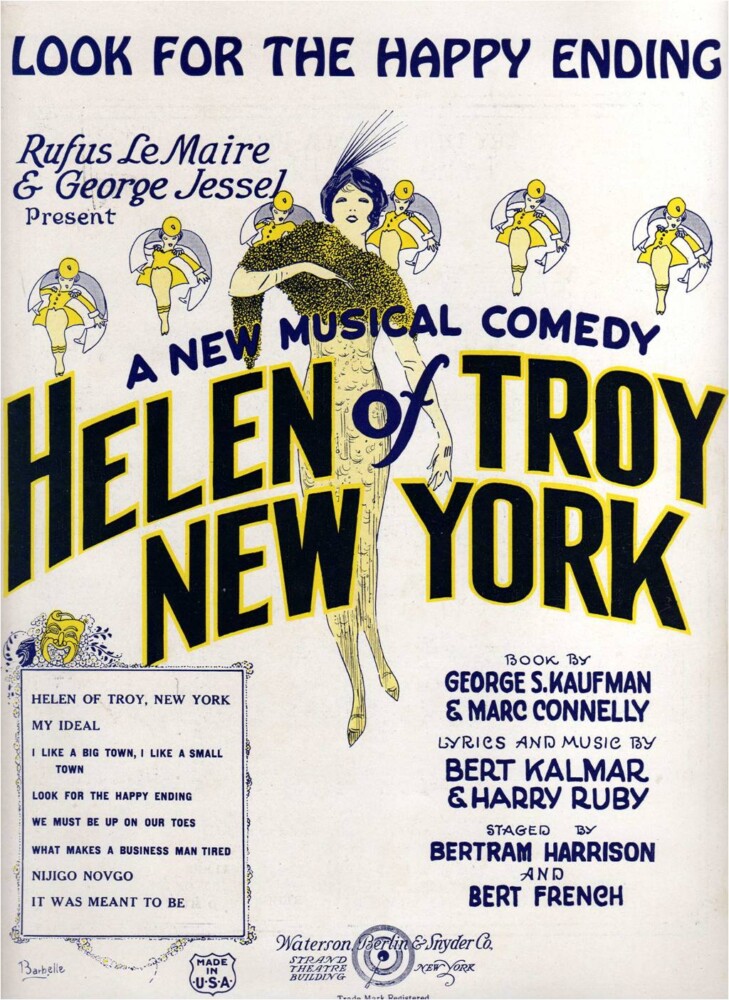

We kick off with the modestly successful business satire Helen of Troy, New York (Selwyn Theatre, 6/19/23, 193), book by George S. Kaufman and Marc Connelly, music by Bert Kalmar and Harry Ruby. It was playwrights Kaufman and Connelly’s first collaboration on a book musical, and the first Broadway score for Kalmar and Ruby.
As noted by Holly Hill in my Encyclopedia of the New York Stage, 1920-1930, whose entries support much of this essay, Helen of Troy, New York is the tale of Irish-American stenographer Helen McGuffey (Helen Ford) who loses her collar-factory job because her boss objects to his son’s romantic interest in her. She then invents a better collar for a rival company that leads to both a business and marital merger.
The Tribune thought the result above the intelligence of the average musical comedy audience, but conceded that it was “a bright travesty, poulticed a little with ballads and a love story.” The Herald praised it as “the perfect musical comedy . . . [and for its] unceasingly delightful book.” Queenie Smith as Helen Ford’s kid sister seems to have stolen the show.
In Scott Meredith’s George S. Kaufman and His Friends, there’s a report on the devious methods used by producer Rufus Le Maire to finagle backing for the show from bootleggers and the notorious gambler Nick the Greek. Le Maire practically tricked song and dance man George Jessel into investing $10,000, his life’s savings, and Jessel in turn fast-talked co-producers Sidney Wilmer and Walter Vincent into putting up $100,000. No one earned a penny when the show’s expenses ate up all its profits.
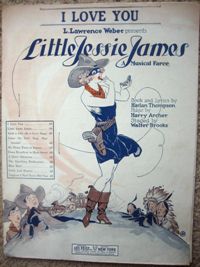

More profitable was the season’s biggest hit, Little Jessie James (Longacre Theatre, 8/15/23; moved to the Little Theatre early in 1924; 385), book and lyrics by local journalist Harlan Thompson, and music by Harry Archer. A bed that appeared and vanished as needed was so important that one critic included it in the cast list. Some likened the book to French bedroom farce, but the racy jokes and one song, “I Love You,” the season’s most popular, which had a long afterlife, helped the show run all season.
In this early example of the low-cost, one-set show, with a small chorus (of eight), the title character (not a Western desperado but so named because she gets what she wants, no matter what) pursues a young man. Paul Revere (Jay Velie) and his roommate, living in an apartment on Central Park West, are poor, lazy, and involved with various women. Jessie Jamieson (Russian-born Nan Halperin, a top vaudevillian) lands Paul after saving him from another man’s wife (future star Miriam Hopkins in her Broadway debut).
The Paul Whiteman Orchestra, which made an appearance, was called “the James Boys” in the program; each musician received an introduction, to the discomfort of the Times critic. Elsewhere, he thought that “the most refreshing member of the cast is a young woman named Miriam Hopkins, possessed of a Francine Larrimore manner, a tremendous head of yellow hair and two nimble legs.”
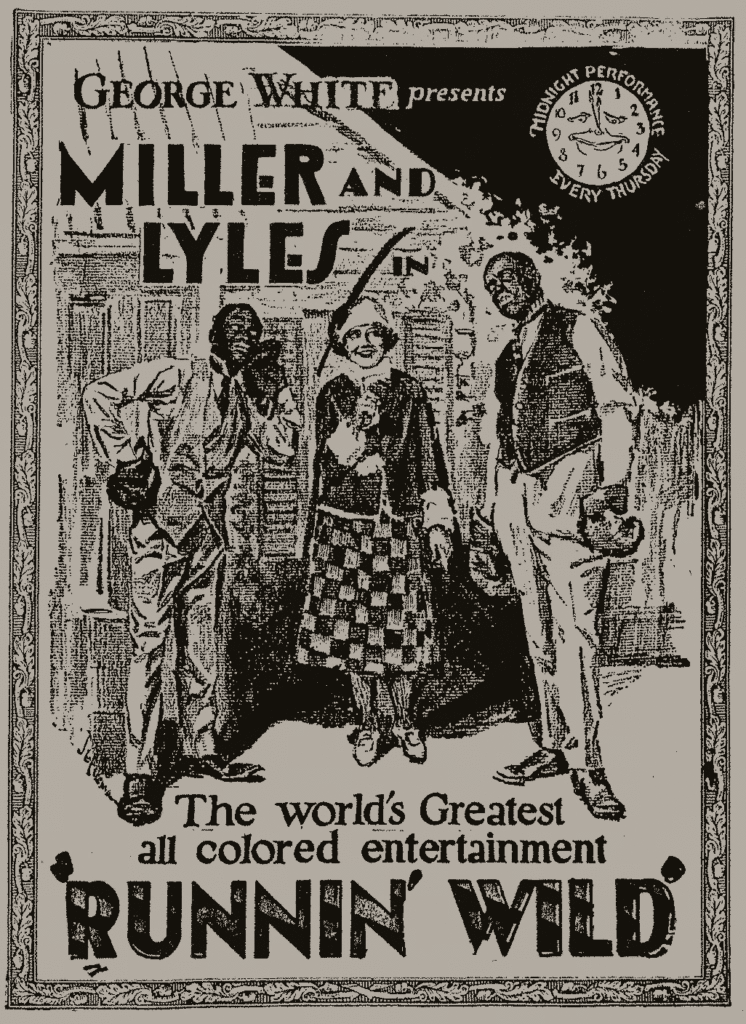

Runnin’ Wild (Colonial Theatre, 10/29/23, 224) might easily have been consigned to the revue category, which indeed is how it’s listed in my aforementioned Encyclopedia, but it’s close enough to a book musical to include here. This was another work from the Black librettist-actors, Flournoy Miller and Aubrey Lyles, who helped create the 1921 hit Shuffle Along. It nearly equaled that success with its new set of farcical adventures for its vaudeville-style characters of sharper Sam Peck (Lyles) and boob Steve Jenkins (Miller). Threatened by the law, Sam and Steve flee Jimtown to save their necks.
The show’s triumph was in spite of the critics, a few of whom were blatantly racist. Time noted that the show had “all the characteristics of an explosion,” and that “Never before has so much enjoyment been concentrated on a single stage.” The Times declared that the show excelled in “eccentric” dancing, “with some of the most exciting steps of the season (steps is not always the word, for knees are used more often than ankles).” He was referring in particular to a number called “Charleston,” which, with the dance craze it inspired, was the cat’s pajamas after being introduced to Broadway here. Those responsible for the music and lyrics were James Johnson and Cecil Mack. James Weldon Johnson wrote of “Charleston,” which was danced by Elizabeth Welsh, backed by a chorus called “The Dancing Redcaps”:
They did not wholly depend upon the orchestra—an extraordinary jazz band—but had the major part of the chorus supplement it with hand and foot patting. The effect was electrical and contagious. It was the best demonstrating of beating out complex rhythms I have ever witnessed; and, I do not believe New York ever before witnessed anything of just its sort.
Miller and Lyles had been appearing in Shuffle Along when producer George White tempted them into Runnin’ Wild with larger salaries. He also stole other talents from that show, including Adelaide Hall and C. Wesley Hill. White might have taken further advantage of the Sissle and Black show by calling it Shuffle Along of 1923, but was prevented from doing so by legal action. The final title was arrived at only after George White’s Black Scandals was discarded.


Stepping Stones (Globe Theatre, 11/6/23, 241) was an apt title for a show not only starring Fred Stone (“the most original and beloved of American clowns,” gushed Burns Mantle) and his wife, Allene Crater Stone, but also gave the spotlight to their teenage daughter Dorothy. It was a musical rendering of the Little Red Riding Hood story, with Father Stone as the rescuer and Mother Stone as the Widow, with Rougette Hood pursued by De Wolfe (Oscar Ragland) before finally being married to the Prince (Roy Hoyer). Locales included the Sweet Shop, Haunted Inn, and Doll’s Village.
Bide Dudley concluded, “’Stepping Stones’ is one of the happiest musicals we ever saw. Everybody in it smiles and keeps things going at top speed. Scenically it is so elaborate it dazzles the eye, and the costuming is beautiful.”
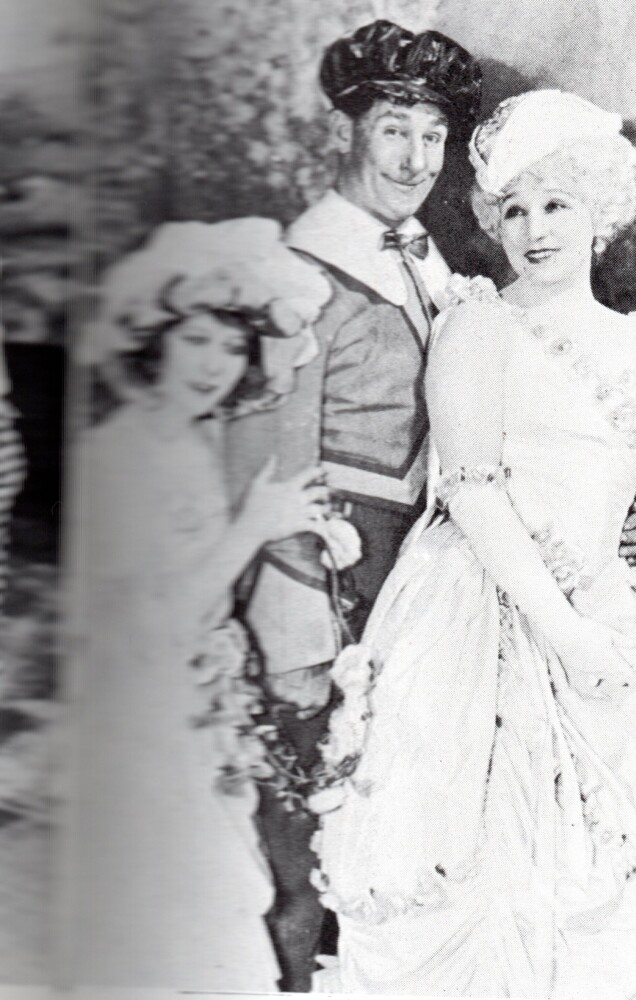

Heywood Broun commented on Dorothy: “This young Stone girl is by all odds the most exciting and glamorous person who has hopped out upon the musical comedy stage in this generation.” Jerome Kern’s score was highly praised, the Times correctly predicting that “In Love with Love” and “Once on a Blue Moon” might be hits.
The show was one of seven forced to close because of a dispute with Equity. It enjoyed a 40-performance return engagement starting on 9/1/24.
We close out our musical comedy survey for 1923-1924 with Kid Boots (Earl Carroll Theatre, 12/31/23, 479), the season’s biggest musical hit, which further boosted the brilliant career of comedian Eddie Cantor, much of whose popularity came from blackface performing. There was no question about the creative team’s credentials: book by William Anthony McGuire and Otto Harbach, music by Harry Tierney, lyrics by Joseph McCarthy, and direction and choreography by Edward Royce. To top it off, Florenz Ziegfeld produced.
Costarring with Cantor was ex-Follies solo dancer Mary Eaton, but it was Cantor’s show. As the Herald reported of his performance in this golf-themed work, “To hear him explain a sex complex during a little putting contest . . . is to throw back one’s head and drop ten years off of one’s life.” Charles Belmont Davis noted what gave Cantor and Eaton their rare appeal: “Personality, supposedly; the ability to establish a friendly relationship with not an audience, but all the separate individuals in an audience.”
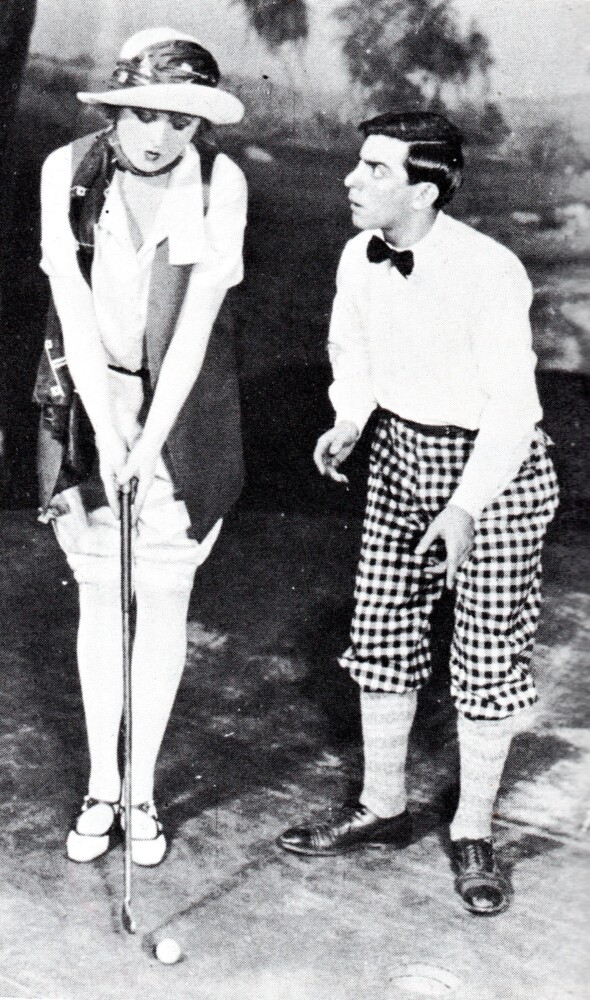

Capitalizing on the burgeoning interest in golf and bootlegging, the book had Cantor as Boots, a caddy master at an exclusive Palm Beach club. Boots deals in crooked halls and bootleg booze, accidentally giving his best friend a bad ball, which loses him the club championship. He manages, though, to arrange a love match between the friend and an heiress (Eaton). (Shows about heirs and heiresses ran rampant at the time.) In one scene, Boots bumbles into the ladies’ locker room, the better to provide an opportunity to display the chorus girls.
Some critics thought the show reminiscent of Sally, with its popular comedian and golden-haired dancer as central figures, although Kid Boots suffered by comparison. The score was lively but it was an interpolated number by Harry Akst, Sam M. Lewis, and Joe Young, “Dinah,” which you can hear Cantor singing here. The song, originally introduced by Ethel Waters, remains a standard.
According to Charles Higham’s Ziegfeld, the idea for the show came when the librettist, composer, and lyricist, having gathered to create a vehicle for Cantor, saw the comedian arrive in such an outlandish golfing outfit that they immediately came up with the show’s concept. Ziegfeld, at first deeply invested in producing the show, suddenly decided to drop it. Only after Cantor ran through it for him, improvising all the roles, did he change his mind.
Cantor tells the story a bit differently in his My Life Is in Your Hands, where he writes that the composer and lyricist devised the idea of a golf-themed play. He gives a detailed account of the entire production, shedding light on how musicals of the time were often shaped specifically to highlight a star. Many of the notions incorporated were actually conceived by Cantor. When the show ended its run, said Cantor, it had grossed what then was the huge sum of $1,750,000. In 1926, Cantor costarred with Billie Dove and Clara Bow in the silent film version of the show.
“Leiter Looks Back” looks forward to continuing these surveys of long-ago Broadway theatre with coverage of the top revues of 1923-1924. To be considered are shows like George White’s Scandals of 1923, Vanities of 1923, The Greenwich Village Follies, The Music Box Revue, Ziegfeld Follies of 1923 . . . you know the drill.


